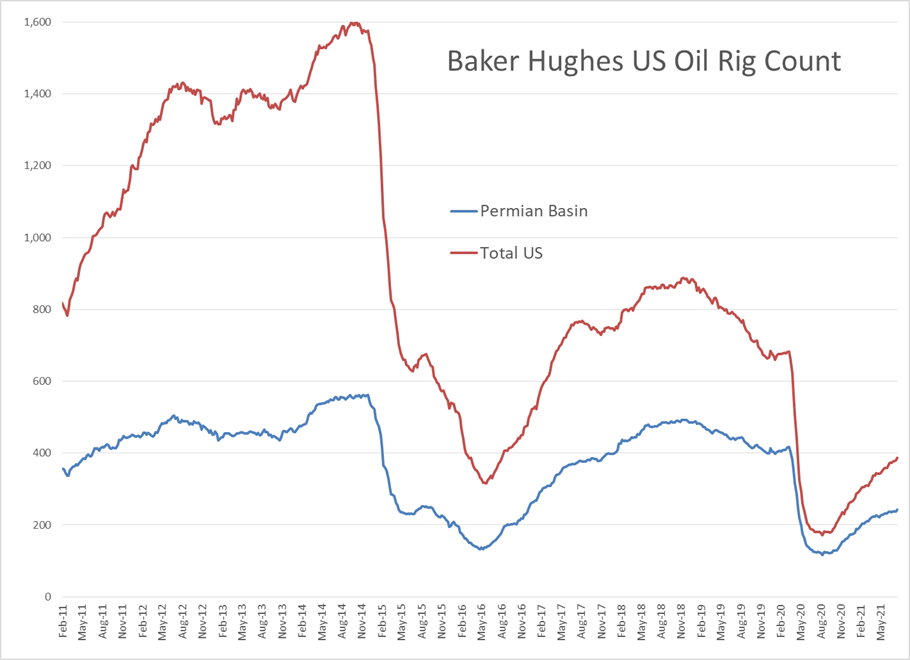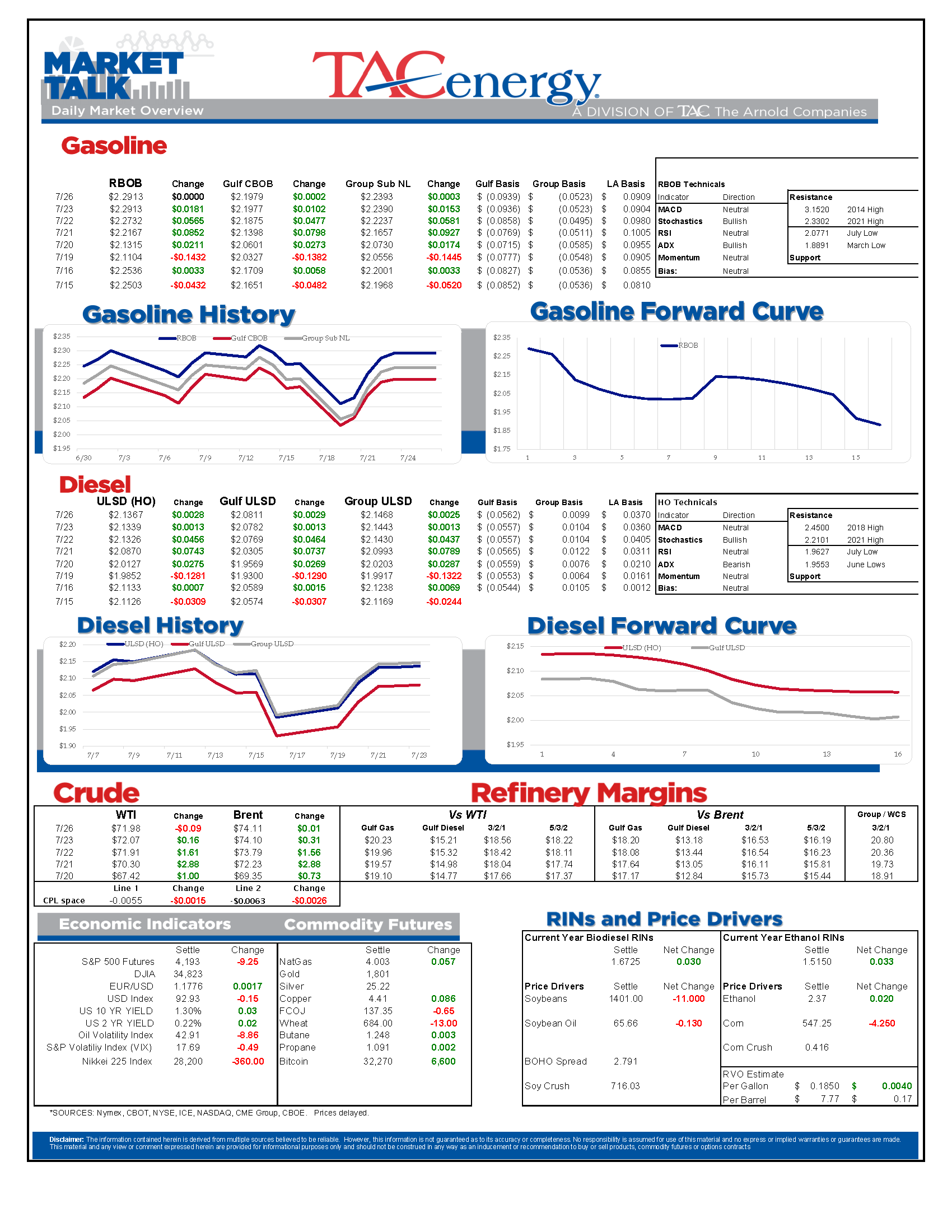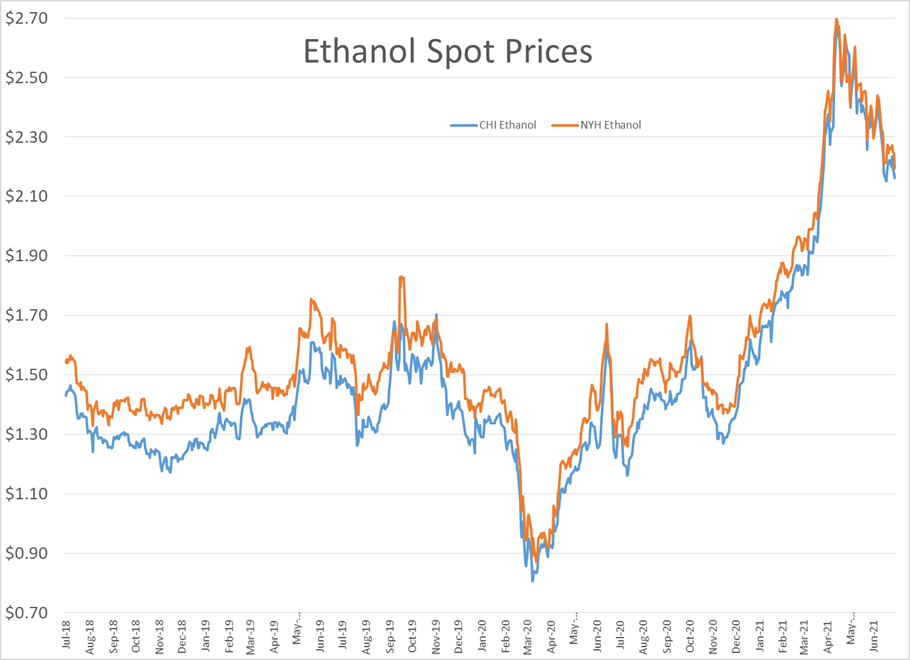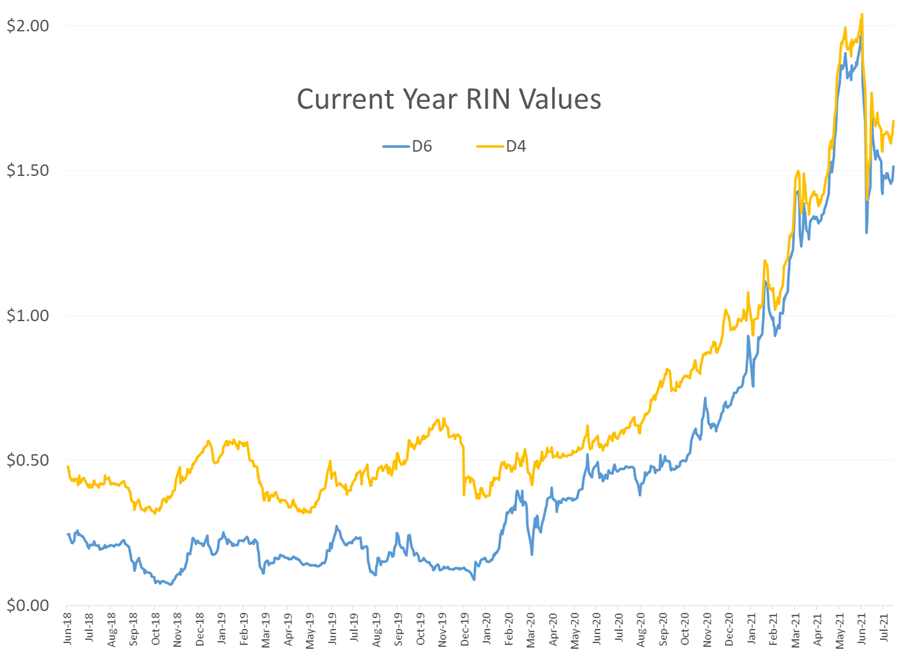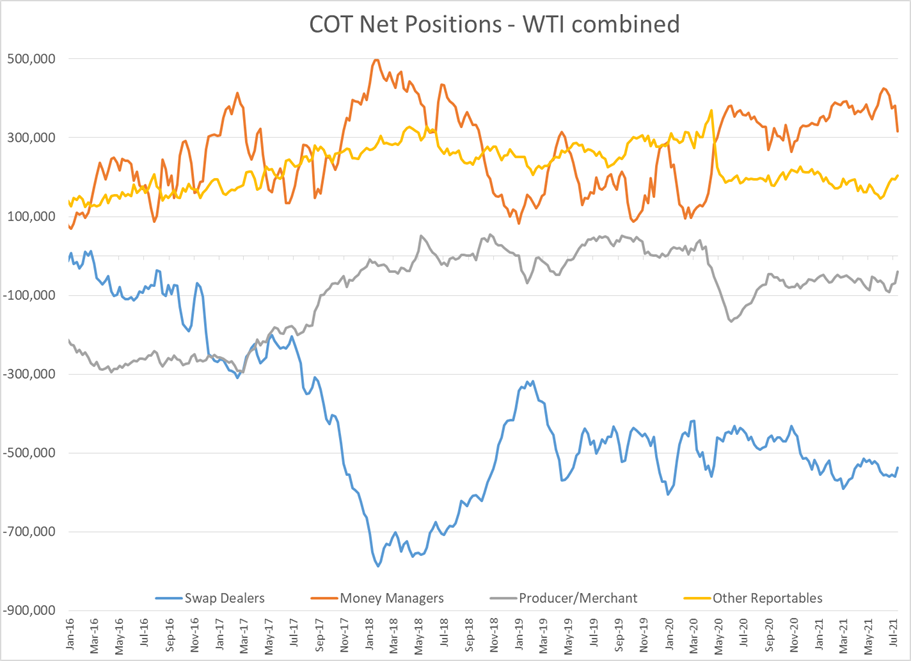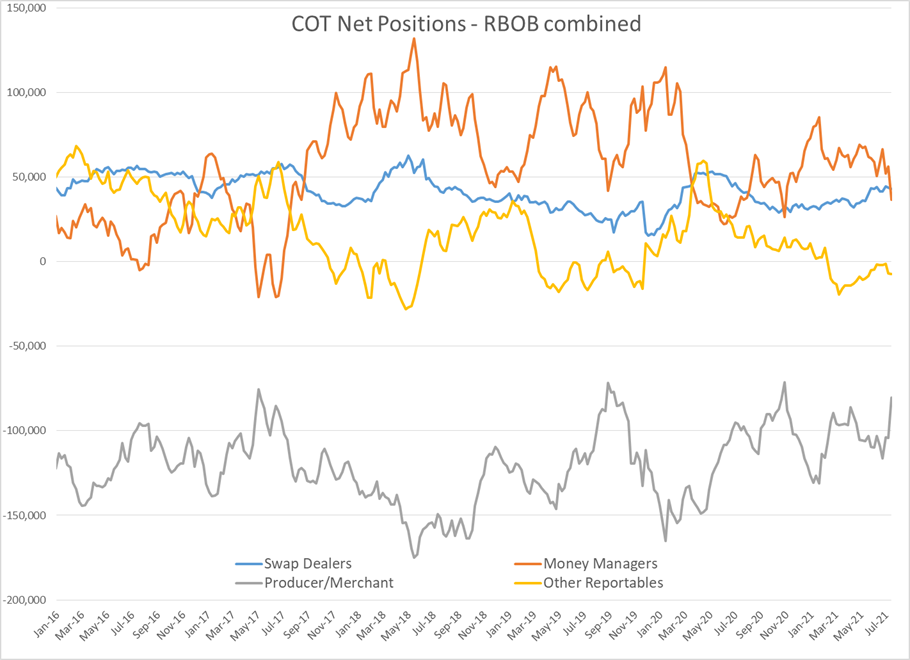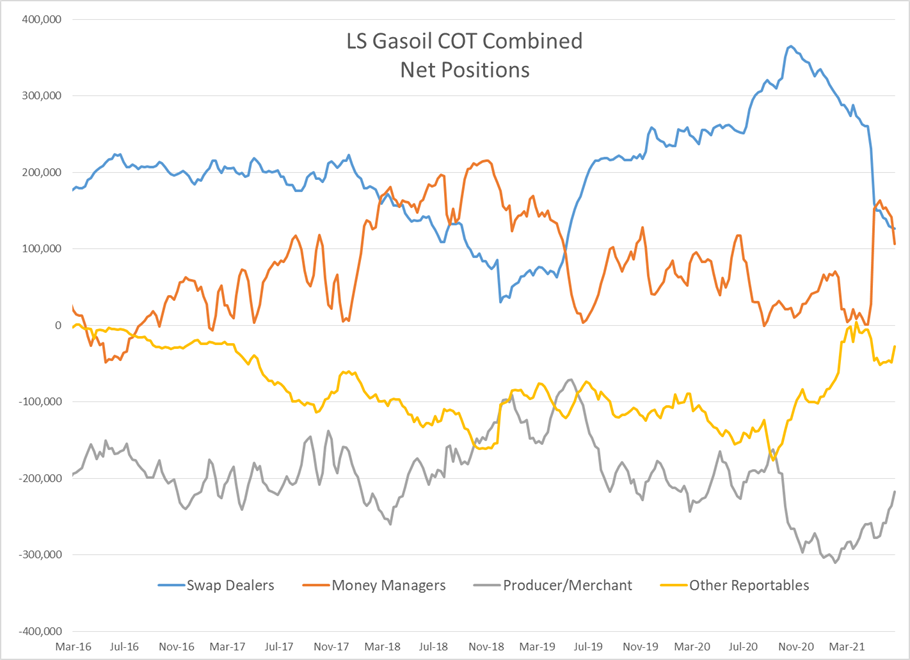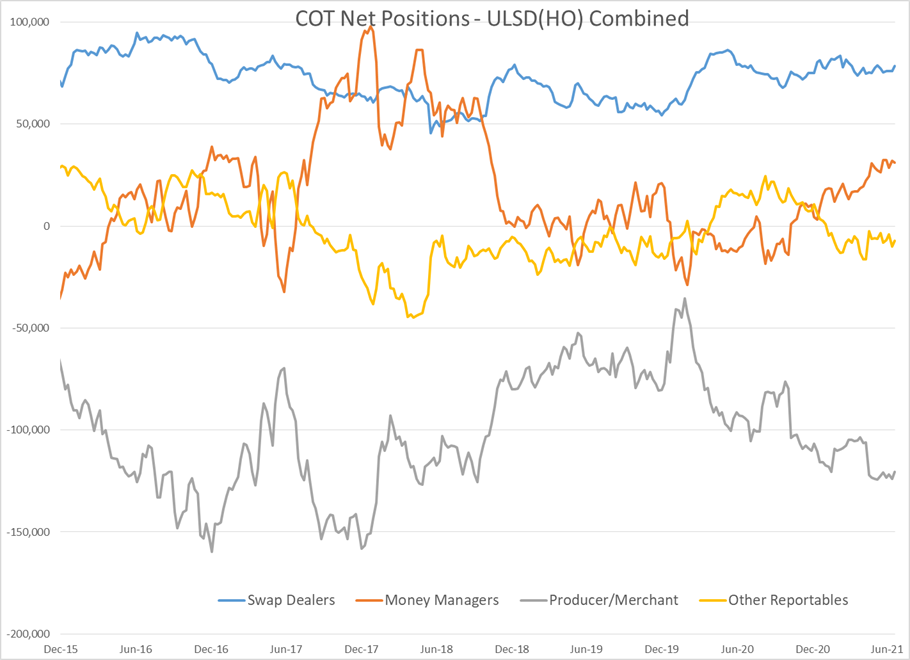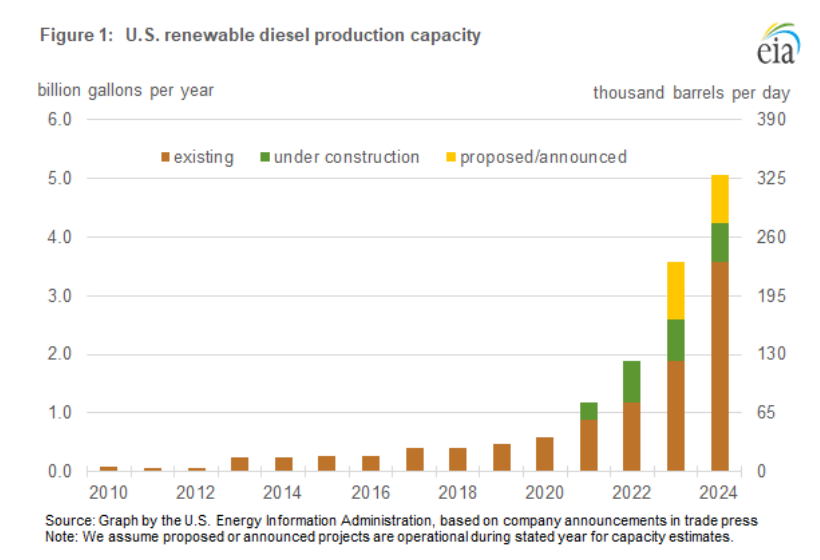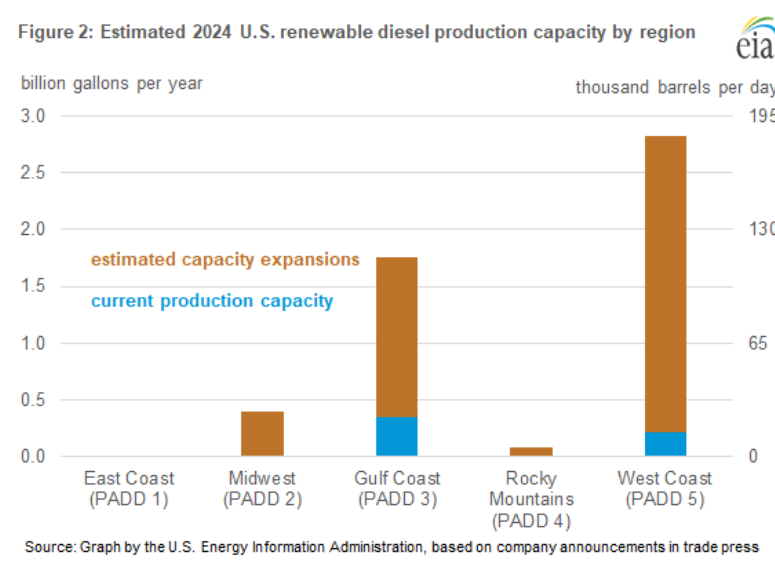Energy Futures Tread Water To Start Last Week Of July

Energy futures are treading water to start the last week of July, and US equity markets are seeing small losses after reaching fresh record highs Friday.
Although volatility has dropped in both energy and equity markets since spiking a week ago, things aren’t as calm as they seem based on current prices, as we did have refined products trading over nearly a nickel range overnight. The last week of July will bring a key test for the energy bulls, that have already passed two big tests so far in July. If prices do not break to fresh highs before month end, there will be an argument that the weekly charts are forming a rounding top pattern that could end up meaning sharply lower prices as we get closer to fall.
Ethanol prices appear to be on the verge of a technical breakdown, along with corn futures which traded below their 200 day moving average for the first time in nearly a year on Friday. That selling in grains didn’t prevent a jump of more than 3 cents in RIN values Friday, although some stronger offers did appear in the afternoon, which could create some downward pressure to start the week, especially with futures flashing red.
Hedge funds look like they may have thrown in the towel after last Monday’s brutal sell-off (and likely missing out on the subsequent rally) with managed money net length seeing sharp reductions across the energy board last week. WTI and RBOB net length plunged to the lowest levels since last October as long positions were cut, and new short positions were added. Those new shorts may help explain the strong rallies in WTI and RBOB Wednesday and Thursday if those new speculative shorts were getting squeezed out. Brent and Gasoil contracts also saw large declines in the large speculator books, while ULSD was the only contract to see a single digit percentage drop on the week, which could end up being a sign of hedge funds struggling to figure this market out as there’s a case that the ULSD contract looks the weakest currently on the charts.
The EIA last week took a closer look at the spike in renewable diesel production expected over the next 3 years, which is forecast to bring US capacity from less than 1 billion gallons/year currently, to nearly 5 billion gallons by 2024. The report notes that even with this surge in production, RD will only account for roughly 20% of West Coast diesel refining capacity, and 4% of USGC capacity after these upgrades are made. The report also highlights the challenges the consequences of higher feedstock and RIN prices caused by this race to take advantage of California’s credits go green.
Baker Hughes reported 7 more oil rigs were put to work last week, continuing the steady increase in drilling activity as producers enjoy the highest prices in nearly 7 years. Unlike the past month, the Permian led the increases this week, with 4 more rigs operating in the country’s largest basin.
Click here to download a PDF of today's TACenergy Market Talk.
Latest Posts
Gasoline Futures Are Leading The Way Lower This Morning
The Sell-Off Continues In Energy Markets, RBOB Gasoline Futures Are Now Down Nearly 13 Cents In The Past Two Days
Week 15 - US DOE Inventory Recap
Prices To Lease Space On Colonial’s Main Gasoline Line Continue To Rally This Week
Social Media
News & Views
View All
Gasoline Futures Are Leading The Way Lower This Morning
It was a volatile night for markets around the world as Israel reportedly launched a direct strike against Iran. Many global markets, from equities to currencies to commodities saw big swings as traders initially braced for the worst, then reversed course rapidly once Iran indicated that it was not planning to retaliate. Refined products spiked following the initial reports, with ULSD futures up 11 cents and RBOB up 7 at their highest, only to reverse to losses this morning. Equities saw similar moves in reverse overnight as a flight to safety trade soon gave way to a sigh of relief recovery.
Gasoline futures are leading the way lower this morning, adding to the argument that we may have seen the spring peak in prices a week ago, unless some actual disruption pops up in the coming weeks. The longer term up-trend is still intact and sets a near-term target to the downside roughly 9 cents below current values. ULSD meanwhile is just a nickel away from setting new lows for the year, which would open up a technical trap door for prices to slide another 30 cents as we move towards summer.
A Reuters report this morning suggests that the EPA is ready to announce another temporary waiver of smog-prevention rules that will allow E15 sales this summer as political winds continue to prove stronger than any legitimate environmental agenda. RIN prices had stabilized around 45 cents/RIN for D4 and D6 credits this week and are already trading a penny lower following this report.
Delek’s Big Spring refinery reported maintenance on an FCC unit that would require 3 days of work. That facility, along with several others across TX, have had numerous issues ever since the deep freeze events in 2021 and 2024 did widespread damage. Meanwhile, overnight storms across the Midwest caused at least one terminal to be knocked offline in the St. Louis area, but so far no refinery upsets have been reported.
Meanwhile, in Russia: Refiners are apparently installing anti-drone nets to protect their facilities since apparently their sling shots stopped working.
Click here to download a PDF of today's TACenergy Market Talk.

The Sell-Off Continues In Energy Markets, RBOB Gasoline Futures Are Now Down Nearly 13 Cents In The Past Two Days
The sell-off continues in energy markets. RBOB gasoline futures are now down nearly 13 cents in the past two days, and have fallen 16 cents from a week ago, leading to questions about whether or not we’ve seen the seasonal peak in gasoline prices. ULSD futures are also coming under heavy selling pressure, dropping 15 cents so far this week and are trading at their lowest level since January 3rd.
The drop on the weekly chart certainly takes away the upside momentum for gasoline that still favored a run at the $3 mark just a few days ago, but the longer term up-trend that helped propel a 90-cent increase since mid-December is still intact as long as prices stay above the $2.60 mark for the next week. If diesel prices break below $2.50 there’s a strong possibility that we see another 30 cent price drop in the next couple of weeks.
An unwind of long positions after Iran’s attack on Israel was swatted out of the sky without further escalation (so far anyway) and reports that Russia is resuming refinery runs, both seeming to be contributing factors to the sharp pullback in prices.
Along with the uncertainty about where the next attacks may or may not occur, and if they will have any meaningful impact on supply, come no shortage of rumors about potential SPR releases or how OPEC might respond to the crisis. The only thing that’s certain at this point, is that there’s much more spare capacity for both oil production and refining now than there was 2 years ago, which seems to be helping keep a lid on prices despite so much tension.
In addition, for those that remember the chaos in oil markets 50 years ago sparked by similar events in and around Israel, read this note from the NY Times on why things are different this time around.
The DOE’s weekly status report was largely ignored in the midst of the big sell-off Wednesday, with few noteworthy items in the report.
Diesel demand did see a strong recovery from last week’s throwaway figure that proves the vulnerability of the weekly estimates, particularly the week after a holiday, but that did nothing to slow the sell-off in ULSD futures.
Perhaps the biggest next of the week was that the agency made its seasonal changes to nameplate refining capacity as facilities emerged from their spring maintenance.
PADD 2 saw an increase of 36mb/day, and PADD 3 increased by 72mb/day, both of which set new records for regional capacity. PADD 5 meanwhile continued its slow-motion decline, losing another 30mb/day of capacity as California’s war of attrition against the industry continues. It’s worth noting that given the glacial pace of EIA reporting on the topic, we’re unlikely to see the impact of Rodeo’s conversion in the official numbers until next year.
Speaking of which, if you believe the PADD 5 diesel chart below that suggests the region is running out of the fuel, when in fact there’s an excess in most local markets, you haven’t been paying attention. Gasoline inventories on the West Coast however do appear consistent with reality as less refining output and a lack of resupply options both continue to create headaches for suppliers.

